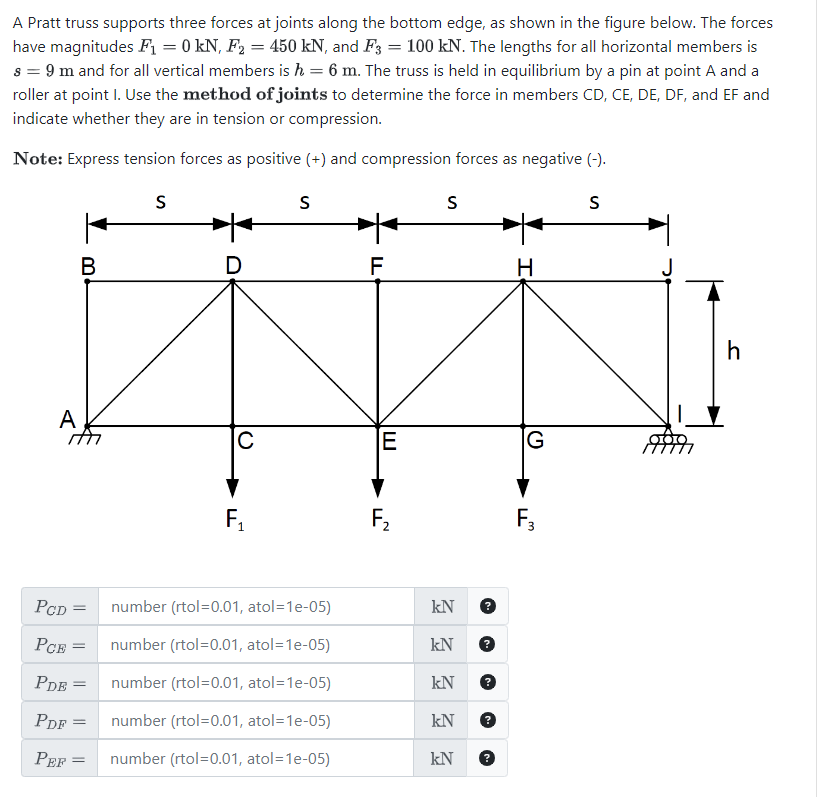A Pratt truss supports three forces at joints along the bottom edge, as shown in the figure below. The forces have magnitudes F₁ = 0 kN, F₂ = 450 kN, and F3 = 100 kN. The lengths for all horizontal members is s = 9 m and for all vertical members is h = 6 m. The truss is held in equilibrium by a pin at point A and a roller at point I. Use the method of joints to determine the force in members CD, CE, DE, DF, and EF and indicate whether they are in tension or compression. Note: Express tension forces as positive (+) and compression forces as negative (-). B S D S F S A C E G F₁ F₂ F3 1 PCD = number (rtol=0.01, atol=1e-05) kN РСЕ = number (rtol=0.01, atol=1e-05) kN PDE = number (rtol=0.01, atol=1e-05) kN PDF = number (rtol=0.01, atol=1e-05) kN PEF= number (rtol=0.01, atol=1e-05) kN S h
A Pratt truss supports three forces at joints along the bottom edge, as shown in the figure below. The forces have magnitudes F₁ = 0 kN, F₂ = 450 kN, and F3 = 100 kN. The lengths for all horizontal members is s = 9 m and for all vertical members is h = 6 m. The truss is held in equilibrium by a pin at point A and a roller at point I. Use the method of joints to determine the force in members CD, CE, DE, DF, and EF and indicate whether they are in tension or compression. Note: Express tension forces as positive (+) and compression forces as negative (-). B S D S F S A C E G F₁ F₂ F3 1 PCD = number (rtol=0.01, atol=1e-05) kN РСЕ = number (rtol=0.01, atol=1e-05) kN PDE = number (rtol=0.01, atol=1e-05) kN PDF = number (rtol=0.01, atol=1e-05) kN PEF= number (rtol=0.01, atol=1e-05) kN S h
Mechanics of Materials (MindTap Course List)
9th Edition
ISBN:9781337093347
Author:Barry J. Goodno, James M. Gere
Publisher:Barry J. Goodno, James M. Gere
Chapter1: Tension, Compression, And Shear
Section: Chapter Questions
Problem 1.4.14P: A crane boom of mass 450 leg with its center of mass at C is stabilized by two cables AQ and BQ (Ae=...
Related questions
Question
please explain how to solve and include a FBD please

Transcribed Image Text:A Pratt truss supports three forces at joints along the bottom edge, as shown in the figure below. The forces
have magnitudes F₁ = 0 kN, F₂ = 450 kN, and F3 = 100 kN. The lengths for all horizontal members is
s = 9 m and for all vertical members is h = 6 m. The truss is held in equilibrium by a pin at point A and a
roller at point I. Use the method of joints to determine the force in members CD, CE, DE, DF, and EF and
indicate whether they are in tension or compression.
Note: Express tension forces as positive (+) and compression forces as negative (-).
B
S
D
S
F
S
A
C
E
G
F₁
F₂
F3
1
PCD = number (rtol=0.01, atol=1e-05)
kN
РСЕ
=
number (rtol=0.01, atol=1e-05)
kN
PDE =
number (rtol=0.01, atol=1e-05)
kN
PDF =
number (rtol=0.01, atol=1e-05)
kN
PEF=
number (rtol=0.01, atol=1e-05)
kN
S
h
Expert Solution
This question has been solved!
Explore an expertly crafted, step-by-step solution for a thorough understanding of key concepts.
Step by step
Solved in 5 steps with 4 images

Knowledge Booster
Learn more about
Need a deep-dive on the concept behind this application? Look no further. Learn more about this topic, mechanical-engineering and related others by exploring similar questions and additional content below.Recommended textbooks for you

Mechanics of Materials (MindTap Course List)
Mechanical Engineering
ISBN:
9781337093347
Author:
Barry J. Goodno, James M. Gere
Publisher:
Cengage Learning

International Edition---engineering Mechanics: St…
Mechanical Engineering
ISBN:
9781305501607
Author:
Andrew Pytel And Jaan Kiusalaas
Publisher:
CENGAGE L

Mechanics of Materials (MindTap Course List)
Mechanical Engineering
ISBN:
9781337093347
Author:
Barry J. Goodno, James M. Gere
Publisher:
Cengage Learning

International Edition---engineering Mechanics: St…
Mechanical Engineering
ISBN:
9781305501607
Author:
Andrew Pytel And Jaan Kiusalaas
Publisher:
CENGAGE L